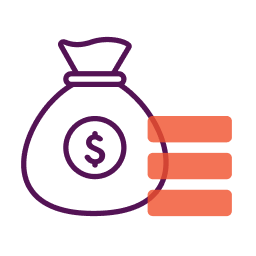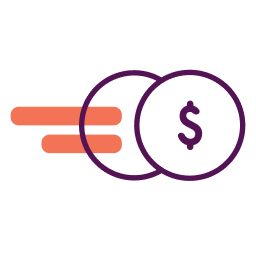On December 22, 2020 Congress passed the new stimulus bill which includes new Paycheck Protection Program loans and new EIDL grants along with other small business relief. Read more about that legislation and apply for a new PPP loan here.
In March of 2020 the SBA introduced two different SBA emergency loans in response to the coronavirus for small businesses seeking financial aid. The first option available to small businesses is the Economic Injury Disaster Loan (EIDL) which is based on the SBA disaster loans used in previous natural disasters like hurricanes, tornadoes, earthquakes, or floods.
Missed out on EIDL & PPP Loans? Nav will match you with small business lenders that meet your needs.
The Paycheck Protection Plan loan is based upon the SBA’s 7(a) loan program (with a few modifications) and is intended to help you keep your employees on the payroll for the eight weeks after you are approved for the loan. To receive forgiveness for you PPP Loan, at least 75% of loan proceeds must have been allocated to payroll-specific expenses:
- Payroll costs
- Costs related to the continuation of group healthcare benefits during periods of paid sick, medical, or family leave,and insurance premiums
- Employee salaries, commissions, or similar compensations
- Payments of interest on any mortgage obligation (but not to pay principal or to prepay a mortgage)
- Rent (including rent under a lease agreement)
- Utilities
- Interest on any other debt obligations that were incurred before the covered period
- Refinancing an SBA EIDL loan made between January 31, 2020 and April 3, 2020
In addition to the EIDL and the PPP, the SBA has made available two other programs that have the potential to help even more small businesses wade through the economic challenges associated with the COVID-19 pandemic.
For those small businesses that currently have a business relationship with an SBA Express Lender, SBA Express Bridge Loans will allow those businesses to quickly access up to $25,000.
The SBA is also providing a financial reprieve to small businesses who already have an SBA small business loan through the SBA Debt Relief program.
Types of SBA Emergency Loans
- Economic Injury Disaster Loan
- CARES Act Paycheck Protection Program
- SBA Express Bridge Loans
- SBA Debt Relief
SBA Express Bridge Loans
On March 25, 2020 the Small Business Administration launched a pilot program to enable small businesses that were already working with an SBA Express Loan Lender to access up to $25,000 quickly. In addition to other SBA emergency loans, the Bridge Loans are intended to provide vital economic support to small businesses to recover from the temporary loss of revenue and provide a loan to bridge the gap while applying for an EIDL while waiting for a decision—and will be repaid either in full or in part by proceeds from their EIDL loan.
The Express Bridge Loan (EBL) Pilot Program has been around since October of 2017 and will expire in March of 2021. These bridge loans are only available for the six months following a Presidential disaster decree and only SBA Express lenders are able to make these loans to eligible small businesses.
What Small Businesses are Eligible for an EBL?
If your business was operational when the declared disaster commenced and you meet all other 7(a) loan eligibility requirements, the SBA states EBL loans may only be made:
- For Presidential Disaster Declarations, small businesses that were located, as of the date of the applicable federal disaster, in Primary Counties that were declared disaster areas under the Presidential Disaster Declaration or in any Contiguous Counties; or
- For the COVID-19 Emergency Declaration, small businesses located in any state, territory and the District of Columbia that have been adversely impacted by the COVID-19 emergency.
EBL Terms
- Maximum loan amount: $25,000
- Maximum guaranty percentage: For an EBL loan, the SBA guaranty percentage is limited to the maximum guaranty percentage for SBA Express Loans. The guaranteed amount of the EBL loan will count towards the maximum SBA exposure that may be outstanding for all SBA loans to a borrower and its affiliates at any one moment.
- Maximum maturity/loan term/interest rate:
- The EBL loan must be structured as a term loan (revolving lines of credit are not permitted).
- The maximum EBL loan term is 7 years.
- The Lender may require the EBL borrower to pay the EBL loan in part or in full if the borrower is approved for long-term disaster financing (including an SBA Direct Disaster Loan) that allows loan proceeds to be used for EBL loan reimbursement.
- The Lende may permit the loan to amortize over a maximum term of 7 years if the borrower does not obtain long-term disaster financing.
- The lender may charge 6.5% over the Prime rate, regardless of the term.
- For variable-rate loans, a Lender may use the same base rate of interest it uses on its similarly-sized non-SBA guaranteed commercial loans; however, the interest rate throughout the term of the loan cannot exceed the maximum SBA Express interest rate allowed of Prime +6.5%.
- A Lender may charge a default interest rate if it does so for its similarly-sized non-SBA guaranteed commercial loans, as long is the interest rate does not exceed the amount stated above.
How Can Loan Proceeds Be Used?
There are some restrictions for how EBL loan proceeds may be used.
- EBL loan proceeds must be used exclusively to support the survival and/or reopening of the small business.
- Lenders must certify in the credit memorandum that the EBL loan proceeds will be used by the borrower to support the survival and/or reopening of the small business. This certification must be included with any guaranty purchase request to the SBA.
- EBL loan proceeds may be disbursed as working capital.
Does the EBL Require Collateral?
The SBA Express collateral policy applies to EBL loans. Because the maximum amount of the EBL loan is $25,000, Lenders are not required to take collateral for EBL loans.
What Are the Credit Requirements for an EBL Loan?
All applications will begin with a screening for a FICO Small Business Scoring Service Score (SBSS Score). The minimum acceptable SBSS score is 130. If the borrower does not receive the minimum SBSS score or greater, the loan is not eligible for the EBL Pilot Program.
The borrower’s personal credit score (for each guarantor) must be satisfactory under the Lender’s standards for its similarly-sized, non-SBA guaranteed commercial loans. The Lender’s credit memorandum for the EBIL loan must document the adequacy of the personal credit score(s).
These particular SBA emergency loans are only available to small businesses with an existing banking relationship with the lender as of the date of the declared disaster in order to mitigate the risks associated with the streamlined underwriting process.
SBA Debt Relief
In addition to other SBA emergency loans, through SBA Debt Relief, the SBA will automatically pay the principal, interest, and fees of any current 7(a), 504, and microloans a small business may have for the period of six months. The SBA will also automatically pay the principal, interest, and fees of any new 7(a), 504, and microloans issued prior to September 27, 2020.
The SBA is also offering automatic deferments through December 31,2020 if you had a disaster loan in “regular servicing” status on March 1, 2020.
In terms of this program, automatic deferment means:
- Interest will continue to accrue on the loan.
- 1201 monthly payment notices will continue to be mailed out which will reflect the loan is deferred and no payment is due.
- The deferment will NOT cancel any established Pre-authorized Debit (PAD) or recurring payments on your loan. Borrowers that have established a PAD through Pay.Gov or an Online Bill Pay Service are responsible for cancelling these recurring payments. Borrowers that had SBA establish a PAD through Pay.Gov will have to contact their SBA servicing office to cancel the PAD.
- Borrowers preferring to continue making payments during the deferment period may continue remitting payments during the deferment period. SBA will allow those payments normally as if there was no deferment.
- After this automatic deferment period, borrowers will be required to resume making regular principal and interest payments. Borrowers tha cancelled recurring payments will need to re-establish the recurring payment.
To apply for a Paycheck Protection Program loan or learn more about the SBA disaster assistance services available to small businesses facing the challenges associated with the COVID-19 pandemic, please visit our COVID-19 Resource Center
Please keep in mind this information is changing rapidly and is based on our current understanding of the programs. It can and likely will change. Although we will be monitoring and updating this as new information becomes available, please do not solely rely on this for your financial decisions. We encourage you to consult with your lawyers, CPAs, and Financial Advisors. To review your real-time funding options with one of Nav’s lending experts, please contact us.
This article was originally written on April 15, 2020 and updated on February 2, 2021.




Have at it! We'd love to hear from you and encourage a lively discussion among our users. Please help us keep our site clean and protect yourself. Refrain from posting overtly promotional content, and avoid disclosing personal information such as bank account or phone numbers.
Reviews Disclosure: The responses below are not provided or commissioned by the credit card, financing and service companies that appear on this site. Responses have not been reviewed, approved or otherwise endorsed by the credit card, financing and service companies and it is not their responsibility to ensure all posts and/or questions are answered.